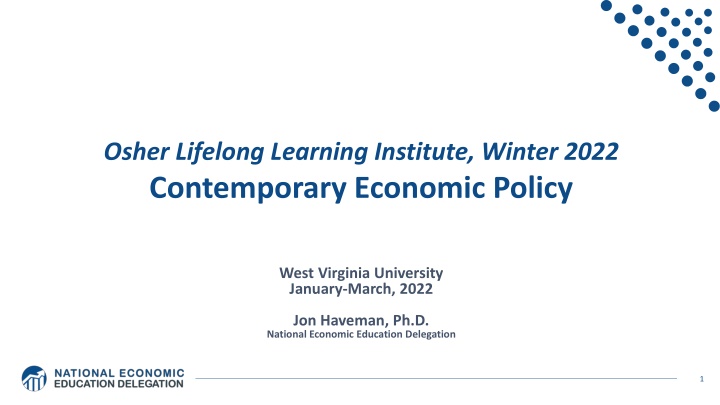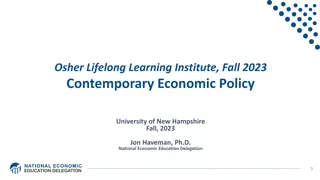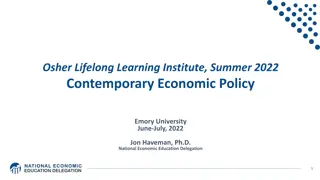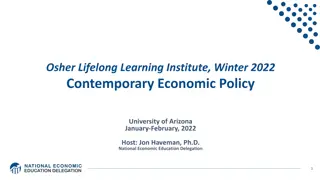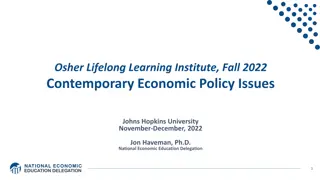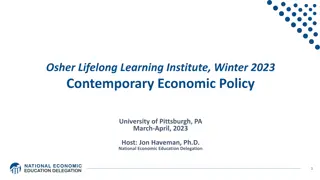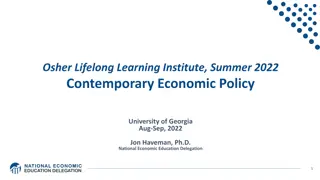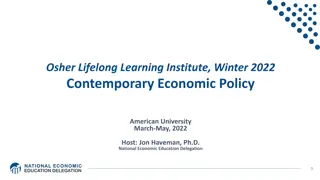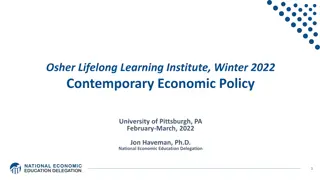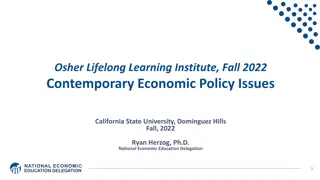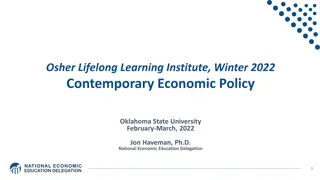Contemporary Economic Policy Insights - Winter 2022
Delve into key economic topics in the Winter 2022 Osher Lifelong Learning Institute course at West Virginia University. Explore coronavirus economics, federal debt, the black-white wealth gap, health economics, monetary policy, and autonomous vehicles. Gain valuable insights into wealth disparities and their implications. Discover policy solutions for addressing economic inequality. This educational opportunity offers a comprehensive overview of pressing economic issues with expert perspectives.
Download Presentation

Please find below an Image/Link to download the presentation.
The content on the website is provided AS IS for your information and personal use only. It may not be sold, licensed, or shared on other websites without obtaining consent from the author.If you encounter any issues during the download, it is possible that the publisher has removed the file from their server.
You are allowed to download the files provided on this website for personal or commercial use, subject to the condition that they are used lawfully. All files are the property of their respective owners.
The content on the website is provided AS IS for your information and personal use only. It may not be sold, licensed, or shared on other websites without obtaining consent from the author.
E N D
Presentation Transcript
Osher Lifelong Learning Institute, Winter 2022 Contemporary Economic Policy West Virginia University January-March, 2022 Jon Haveman, Ph.D. National Economic Education Delegation 1
Available NEED Topics Include: Coronavirus Economics Immigration Economics US Economy Housing Policy Climate Change Federal Budgets Economic Inequality Federal Debt Economic Mobility Black-White Wealth Gap Trade and Globalization Autonomous Vehicles Minimum Wages US Social Policy 2
Course Outline Contemporary Economic Policy - Week 1 (1/27): US Economy & Coronavirus Economics - Week 2 (2/3): Federal Debt (Geoffrey Woglom, Amherst College) - Week 3 (2/10): The Black-White Wealth Gap (Me) - Week 4 (2/17): Health Economics (Veronika Dolar, SUNY, Old Westbury) - Week 5 (2/24): Monetary Policy (Geoffrey Woglom, Amherst College) - Week 6 (3/3): Autonomous Vehicles (Me) 3
The Black-White Wealth Gap Jon Haveman, Ph.D. National Economic Education Delegation 4
Credits and Disclaimer This slide deck was authored by: - Darrick Hamilton, Ph.D., The New School - Jon Haveman, Ph.D., NEED Disclaimer - NEED presentations are designed to be nonpartisan. - It is, however, inevitable that the presenter will be asked for and will provide their own views. - Such views are those of the presenter and not necessarily those of the National Economic Education Delegation (NEED). 5
Outline Evidence of disparities Why wealth is important Sources of disparities Implications of disparities Policy solutions 6
Evidence 7
Evidence of the Gap Mean is 7x Greater Median is 8x Greater 8
Wealth Disparities, 2019 Race/Ethnicity Mean Wealth Share of Families Share of Wealth Ratio of Shares White, non-Hispanic $983,400 64.9 85.3 1.3 Black, non-Hispanic $142,500 14.2 2.7 0.2 Hispanic or Latino $165,500 9.6 2.1 0.2 Other or Multiple Race $657,200 11.3 9.9 0.9 9 Source: Federal Reserve, Survey of Consumer Finances
Overall Wealth Distribution 2019 Overall Median: $121,700 10
Wealth is More and More Concentrated 99th Percentile 2016 = 7x 1963 11 Source: Urban Institute
Net Worth by Age and Race 14 Source: https://www.brookings.edu/blog/up-front/2020/02/27/examining-the-black-white-wealth-gap/
Black Household Incomes Relative to White 15 Source: pewsocialtrends.org
Widespread Household Wealth Pays Dividends To individuals in the household - Choices/Agency - Wealth is iterative And to broader society - Human capital development - Entrepreneurship and innovation 19
Household Level Benefits Choices/Life Agency - Finance higher education - Living in good neighborhoods - Saving for retirement - Capital to start a business - Withstand financial hardship - Better legal counsel - Exert political influence - Finance costly medical procedure - Bequests Wealth is iterative - Wealth begets more wealth. o Access to higher return investments. - Wealth transfers across generations. o Wealth is sticky. 20
Parental Wealth is Important Important pre-estate transfer effects on kids: - Influences human capital accumulation. - Influences the returns to education. - Adult incomes of offspring. There are clearly enormous differences in wealth held by parents of Black and White children. And it s clear that nurture plays a big roll. 21
Mobility Example: Perfect Mobility 23 https://www.demos.org/blog/absolute-and-relative-mobility-short-primer
Tangible Benefits for the Broader Economy More human capital development Increased entrepreneurship Greater labor force participation Healthier labor force Less social unrest Less reliance on social programs Smaller stock of student loans 24
Events/Policies with Direct Wealth Implications Slave trade - The first deprivation. Slavery 40 acres (and a mule) - The second deprivation. - Discriminatory distribution of land. Freedmen s Bank - Lax oversite and dissolution. Jim Crow Laws & Economic Policy - Convict leasing, debt peonage, chain- gang, sharecropping, and lynching. Homestead Act - Discriminatory distribution of land. Land theft and destruction - E.g., Black Wall Street Tulsa, 1921. GI Bill - Discriminatory access Levittown Federal Housing Authority - Redlining And many more. 26
Results for Black Families Much lower accumulation of wealth than among White families. Implications: - Less financial contribution from parents to children. o More difficult access to higher education. o Less access to capital for business formation. - More likely to live in disadvantaged neighborhoods. o Fewer role models. o Less access to quality education. - Disparities in the capacity availability of resources - to build wealth. 27
Potential Explanations: Differences in Educational attainment Home ownership Increased savings Financial literacy Entrepreneurship Soft skills and personal responsibility Wages Labor force participation Family disorganization Initial endowment 28
Wealth by Educational Attainment Educational Attainment Net Worth Median Net Worth Mean 71.0% No High School $22,800 $157,200 High School $67,100 $249,600 Some College $66,100 $340,600 16.1% College $292,100 $1,511,100 8.6% 4.3% 29 Source: Federal Reserve Board, Table data are 2016.
Educational Attainment Median Household Net Worth by Race and Education 30 Source: Darity, et al., What We Get Wrong About Closing the Racial Wealth Gap
Educational Attainment: Policy How do we increase educational attainment? - Increase universal quality of public schools. - Increased/improved counseling in high schools. - Reduce costs (including living) of attending college. - Increased access to funds for education. - Make publicly available pre-k education. - Mandate kindergarten by age 5. - No one able to drop out before age 18 or at least 11 completed years of education. 31
Home Ownership: 2016 Net Worth Median Net Worth Mean Housing Status Renters $5,200 $91,100 Owner $231,400 $1,034,200 Median Net Worth by Race 33
Wealth Equality Through Home Ownership? Well-documented evidence of historical and ongoing housing and lending discrimination. - Appraisals, buyers, lenders, local laws, covenants What about home prices in minority neighborhoods? Even if they buy, they won t get the appreciation of White neighborhoods. - Home values are 50% lower in majority Black neighborhoods. o 23% after adjusting for quality and amenities. 34 Source: Brookings, Home ownership while black
What Determines Differences in Home Ownership? Wealth of parents Ability to borrow lending discrimination - At all - On equivalent terms to white borrowers Local ordinances housing discrimination Lower appreciation rates of homes in majority Black communities. - This makes it a less attractive investment. 35
Increased Savings Historical evidence generated by economists ranging from Milton Friedman (1957) to Marjorie Galenson (1972) to Marcus Alexis (1971) to Gittelman and Wolff (2004) .. - All find that after accounting for household income, Blacks have a slightly higher savings rate than Whites. Assertion: risk and reward are higher for White investors - Controlling for income, this is not clear. - Access to and tolerance for higher risk investments is clearly correlated with income. 36
Financial Literacy Financial literacy doesn t matter that much when you don t have any finances to manage. - The insufficient financial literacy argument is often leveled specifically at Black households. o The argument holds equally with regard to all households of comparable incomes. Controlling for household income, there is no difference in rates of asset appreciation between Black and White households. 37
Use of Payday Lenders 38 Source: Federal Reserve Bank of New York; Survey of Consumer Finances
Use of Payday Lenders 39 Source: Federal Reserve Bank of New York; Survey of Consumer Finances
Entrepreneurship: Rate of New Entrepreneurs 40 Source: Statistica
Explaining Differences in Entrepreneurship Disparities in access to capital: - Wealth disparities o Specifically - differences in home equity. o Differences in wealth levels of friends and family. - Less likely to rely on banks and more likely to rely on credit cards. - Loans have higher interest rates if they can get them. - Less access to venture funds. Generally lower levels of education. Previous business ownership by family members. Different stocks of relevant social capital. 41
Soft Skills and Personal Responsibility Reality - Black workers are crowded into service sector jobs. - Well represented in service, sales and office, and production, transportation, and material moving. - Relatively less well represented in construction, extraction, and maintenance. Employability - Show up on time. - Eye contact with customers. - Dress well. - Collaborative skills. 42
Wage Gap 43 Source: https://www.frbsf.org/economic-research/publications/economic-letter/2017/september/disappointing-facts-about-black-white-wage-gap/
Overrepresented Where Wages are Low 44 Source: Hamilton Darrick, Algernon Austin, and William Darity, Jr. Whiter Jobs, Higher Wages :Occupational Segregation and the Lower Wages of Black Men Economic Policy Institute, Briefing Paper #288 2011.
Black-White Earnings Gap by Education 45 Source: https://www.frbsf.org/economic-research/publications/economic-letter/2017/september/disappointing-facts-about-black-white-wage-gap/
Wage Gap Broken Down 46 Source: https://www.frbsf.org/economic-research/publications/economic-letter/2017/september/disappointing-facts-about-black-white-wage-gap/
Equality of Income = Equality of Wealth / 47 Source: http://hartfordinfo.org/issues/wsd/FamiliesandChildren/Racial-Wealth-Gap-Brief.pdf
